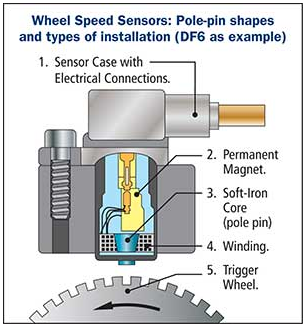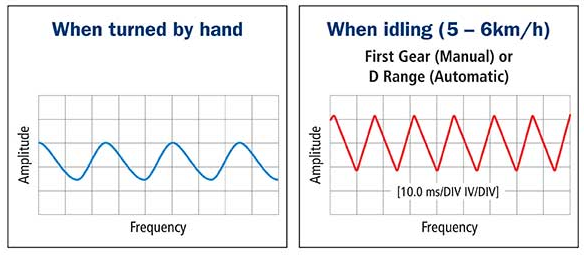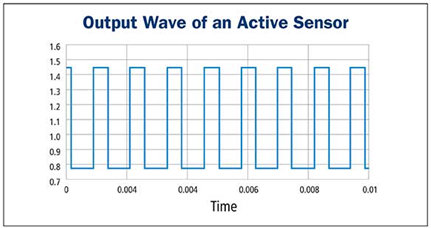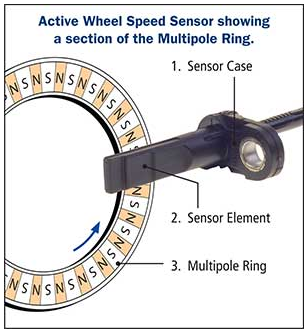About Wheel Speed Sensors – More than just ABS
When Wheel Speed Sensors first appeared on vehicles they were predominantly for Anti-Lock Braking Systems (ABS). In today’s modern vehicles they are used by many different systems.
With manufacturers focusing on, and the customer demanding improved safety, Speed Sensors have become a vital component in the operation of many of the vehicles intelligent safety systems and other vital vehicle operations.
Intelligent data transmission systems like Controller Area Network (CAN) has allowed several control units to use the data. When it comes to driving safety, speed sensors play a vital role and this is reflected in the number of vehicle systems that rely on them.
They are used by the control units in driving assistance systems including ABS, TCS (Traction Control System), ESC (Electronic Stability Control) ADAS (Advanced Driver Assist System) and ACC (Adaptive Cruise Control) and others to detect wheel speed.
This Wheel Speed Sensor information may also be used by the engine management system, transmission control module and navigation system.
Wheel Speed Sensors now have an impact on the vehicle dynamics, driving comfort, safety, emissions and fuel consumption.
What the Technician Needs to Know
Wheel Speed Sensors come in 2 types, passive or active. Passive sensors are inductive analogue type and active sensor are digital hall sensor type. Active sensors need a power supply to work. Passive sensors do not
Passive/Inductive wheel speed sensors
A typical inductive Wheel Speed Sensor comprises of a coil of wire wound around a soft iron core connected to a permanent magnet. This sensor is positioned close to the trigger wheel (impulse wheel, tone wheel) which is attached to the wheel hub or drive shaft. The rotation of the trigger wheel and the resulting movement from tooth to tooth varies the sensor magnetic field inducing an alternating voltage into the sensor coil. The frequency and amplitude of the induced voltage is proportional to wheel speed. At slow speeds the signal can become inaccurate on this type of sensor. The position of the sensor in relation to the trigger wheel is vital and damage can be done when work is done in the area.
This type of wheel speed sensor does not require an external power supply to produce an output signal and generally has a 2 terminal connector.



Active Wheel Speed Sensors
Unlike passive Wheel Speed Sensors, active wheel speed sensors have integrated electronics and is supplied with a defined voltage from the ABS module. There are two types of active sensors, the magneto-resistive type and those using a hall sensor. Both sensors look similar to the passive sensor and may come with 2 or 3 terminals. Active wheel speed sensors produce a digital signal.

This digital wheel speed sensor may be triggered either by a series of opposing magnets around a multipole ring (encoder) or using a toothed ring similar to the passive type. The encoder can be inside the wheel bearing, on the wheel bearing or on the wheel carrier.
The advantage of the active wheel speed sensor is that can accurately monitor all wheel speeds (including stationary) and dual element sensors can also monitor reverse rotation

Advantages of Active Sensors
- Wheel speed detection from stationary. This allows speed measurements down to 0.1 km/h, which is important to traction control and hill decent control.
- The sensor is smaller and lighter.
- Insensitivity to vibration and temperature fluctuations.
- Less sensitive to changes in air gap.
- Less electromagnetic interference.
- Detect forward and reverse movement.
Electric (BEV) and Hybrid Vehicles (HEV, PHEV)
Electric and hybrid vehicles use regenerative braking to slow the vehicle but still have a conventional braking system. They still need and have wheel speed sensors for the ABS, traction control and many other systems. The wheel speed sensors used on electric vehicles are the same as used on an internal combustion engine vehicle and will require maintenance and repair. Premier Auto Trade’s range of wheel speed sensors is continuously growing and covers BEV’s and HEV’s. This includes the Tesla range.
Future Evolution of Transport
Wheel speed sensors have evolved significantly since their introduction. The popularity of EV’s is expected to grow in the future, the evolution of all systems will continue. PAT are constantly working with OE suppliers and manufacturers to ensure we stay up to date with the latest technologies including electric vehicles. This constant research and development allows PAT to have the parts and technical knowledge available to our clients as transportation evolves.

